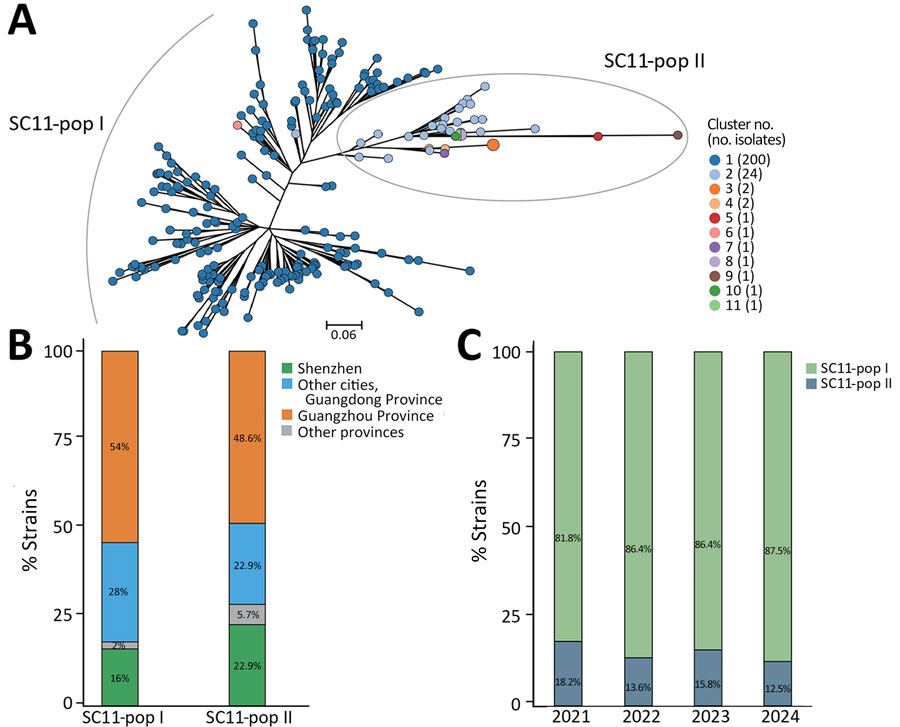Rapid Transmission and Divergence of Vancomycin-Resistant Enterococcus faecium Sequence Type 80, China
Liqiang Li
1, Xingwei Wang
1, Yanyu Xiao, Bing Fan, Jiehong Wei, Jie Zhou, Zetian Lai, Yanpeng Zhang, Hongmei Mo, Li Zhang, Dixian Luo, Dayong Gu, Shucai Yang, Yidi Wang, Jiuxin Qu

, and
Shenzhen Pathogen Infection Research Alliance (SPIRA)
Author affiliation: Shenzhen Third People’s Hospital Department of Clinical Laboratory; National Clinical Research Center for Infectious Diseases, Second Affiliated Hospital of Southern University of Science and Technology, Shenzhen, China (L. Li, X. Wang, Y. Xiao, Y. Wang, J. Qu); Shenzhen Institute of Translational Medicine, First Affiliated Hospital of Shenzhen University, Shenzhen Second People’s Hospital, Shenzhen (B. Fan, Y. Zhang, D. Gu); Medical Laboratory of the Third Affiliated Hospital of Shenzhen University, Shenzhen (J. Wei, H. Mo); Pingshan Hospital, Southern Medical University, Pingshan District People’s Hospital of Shenzhen, Shenzhen (J. Zhou, L. Zhang, S. Yang); Shenzhen Nanshan People's Hospital, Shenzhen (Z. Lai, D. Luo); Shenzhen University Medical School, Shenzhen (Z. Lai, D. Luo)
Main Article
Figure 2

Figure 2. Lineages detected in a study of rapid transmission and divergence of vancomycin-resistant Enterococcus faecium ST80, China, showing 2 lineages circulating in parallel. A) SC11 subpopulations labeled on pangenomic tree inferred from gene presence and absence matrix. Eleven clusters were delineated in PopPUNK, labeled in different colors. Clusters 1 and 2 are the 2 major populations. Cluster 6 (1 strain) is nested in cluster 1 (200 strains) on the pangenomic tree and thus are denoted together as SC11-pop I, whereas strains from clusters 3–11 (except cluster 6, 10 strains together) are nested in cluster 2 (24 strains) and are denoted as SC11-pop I. Scale bar is unit of tree branch length, indicating the genetic distance stimulated from gene presence and absence matrix using roary (https://sanger-pathogens.github.io/Roary). B) Parallel circulation of SC11-pop I and SC11-pop II strains from 2021 to 2024. C) Geographic distribution of SC11-pop I (n = 200) and SC11-pop II (n = 35) strains. Prevalence is displayed in percentage. pop, population; SC, sequence cluster; ST, sequence type.
Main Article
Page created: March 24, 2025
Page updated: April 25, 2025
Page reviewed: April 25, 2025
The conclusions, findings, and opinions expressed by authors contributing to this journal do not necessarily reflect the official position of the U.S. Department of Health and Human Services, the Public Health Service, the Centers for Disease Control and Prevention, or the authors' affiliated institutions. Use of trade names is for identification only and does not imply endorsement by any of the groups named above.
